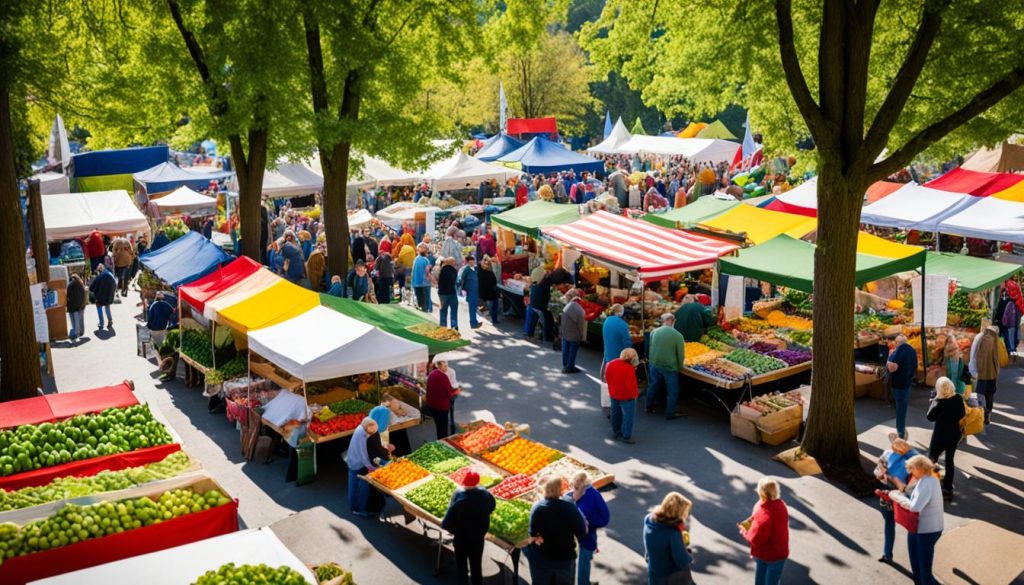Seasonal Foods show off nature’s best, with Fresh Ingredients at their best during various times. Eating these Peak Produce makes our meals taste better and is good for our health. It also links us to local farms and traditions, letting us feel the Earth’s rhythms.
It’s key to enjoy these seasonal foods for their health perks and to eat in a way that’s good for the planet. By choosing seasonal foods, we make tasty choices that help the environment.
Key Takeaways
- Seasonal Foods offer optimal flavor and nutrition.
- Fresh Ingredients reflect regional availability and cultural practices.
- Peak Produce supports local farmers and economies.
- Seasonal Eating promotes sustainability and reduces carbon footprints.
- Connecting with the seasons enhances dining experiences.
Understanding the Concept of Seasonal Foods
Seasonal foods are linked to the farming cycle. They are at their best in taste and nutrition during certain times. By eating seasonally, people can improve their cooking and help local farmers and the planet. Each season offers new and exciting ingredients to try.
The weather in the U.S. affects what foods are available. For example, warm areas have citrus fruits in winter, while cool places have root vegetables in fall. This knowledge helps us appreciate local farming and eating seasonally.
Eating seasonally makes us think differently about our diets and visit local markets more. It leads to healthier eating and a closer bond with our food. As the farming cycle changes, so does the chance to enjoy fresh, tasty produce that highlights each season’s best.
Benefits of Eating Seasonal Foods
Eating seasonal foods is good for your health and the planet. It helps you make better choices at markets and stores.
Nutritional Benefits of Seasonal Produce
Seasonal fruits and veggies are packed with nutrients and taste great. They have more vitamins and minerals because they’re picked when ripe. This makes your meals healthier and more delicious.
Choosing local produce means you get the best taste and quality. It’s food at its best, right from where it’s grown.
Environmental Impact: Reducing Food Miles
Seasonal foods cut down on food miles, the distance food travels. This helps reduce carbon emissions and supports green farming. Plus, it helps local farmers by keeping money in the community.
Studies show eating seasonally is good for the planet and local economies. It makes the food system more sustainable.
Seasonal Meal Planning for Every Season
Seasonal Meal Planning lets us enjoy the best flavors all year. By using Spring Produce and Summer Ingredients, we can make dishes that celebrate each season. Here’s how to add these fresh ingredients to your meals.
Spring: Fresh Greens and Herbs
Spring brings fresh greens and herbs. Adding spinach, arugula, and basil to meals boosts flavors and nutrition. Here are some ideas for spring produce:
- Spring Salad: Mix greens with fresh herbs, radishes, and lemon vinaigrette for a refreshing start.
- Herb-Infused Pasta: Toss whole wheat pasta with garlic, spinach, and fresh basil.
- Vegetable Stir-Fry: Use asparagus and snap peas for a colorful stir-fry with your favorite protein.
Summer: Vibrant Fruits and Veggies
Summer offers colorful fruits and vegetables. Seasonal Meal Planning in summer encourages creativity. Popular summer ingredients include berries, tomatoes, and peppers. Here are some meal ideas:
- Summer Fruit Salad: Mix blueberries, strawberries, and watermelon for a refreshing dish.
- Grilled Veggie Skewers: Marinate cherry tomatoes, bell peppers, and zucchini for a tasty barbecue side.
- Tomato Basil Bruschetta: Top toasted baguette with fresh tomatoes, basil, and balsamic drizzle for a great appetizer.
Seasonal Foods and Culinary Trends
Culinary trends now focus more on seasonal foods. Chefs and home cooks use fresh, local ingredients. This connects cooking with nature’s cycles. It also leads to more sustainable and quality cooking.
Farm-to-table dining is key in this new cooking world. Top chefs in the U.S. create menus that use the best seasonal ingredients. This not only makes food taste better but also helps local farmers and communities.
Social media lets home cooks share their seasonal recipes. Pictures of fresh produce and new dishes inspire others to try local foods. By cooking with the seasons, people join a movement that values cooking and eating with nature.
Using seasonal foods in cooking shows a deep respect for quality, sustainability, and the art of cooking. This trend is changing how we view food. It encourages us to enjoy nature’s gifts every season.
Where to Find Seasonal Foods
Finding seasonal foods can make your cooking better and help local farmers. You can find these foods at Farmers Markets and Farm-to-Table restaurants. Both places have great benefits for those who care about where their food comes from.
Local Farmers Markets: Your Go-To Source
Farmers Markets are ideal for finding seasonal foods. You can buy directly from local farmers, ensuring the food is fresh and tastes great. This direct sale builds a community and helps local economies.
Customers can talk to farmers and learn about how their food is grown. This shows the effort farmers put into their work.
Farm-to-Table Restaurants and Their Appeal
Farm-to-Table restaurants add another level of appreciation for seasonal foods. They focus on using ingredients from local farms. Chefs make dishes that highlight what’s in season.
This approach supports sustainability and brings out the best in local produce. Diners get to taste unique flavors and help local farmers by eating there.

Locally Grown Produce: A Sustainable Choice
Choosing locally grown produce makes your meals better and helps our planet. It supports sustainable farming, which helps local farmers and grows the economy.
Local ingredients travel less, which means less carbon emissions. This helps fight climate change and protect our environment. By picking local produce, you help create a sustainable food system that cares for the earth and communities.
Sustainable farming is key to a healthy planet. It uses methods that make soil better and protect many kinds of plants and animals. Local farms often use these methods, keeping the land fertile and safe for the future.
- Encourages community development.
- Promotes biodiversity through varied crop growth.
- Contributes to fresher, more nutrient-dense food options.
Switching to local produce helps farmers and makes you healthier. It connects you to where your food comes from. You’ll see the hard work behind every meal.
Understanding Crop Rotation and Its Importance
Crop rotation is key to sustainable farming. It means changing the crops grown on the same land over time. This method boosts soil health and makes farming more resilient. By growing different crops, farmers improve the quality and variety of seasonal foods.
How Crop Rotation Affects Seasonal Foods
Crop rotation helps recycle nutrients in the soil, vital for healthy seasonal foods. Each plant needs different nutrients, so rotating crops keeps the soil rich. This leads to:
- Improved soil structure, which holds water better and prevents soil loss.
- Controlled pest populations, as some crops keep pests away from others.
- Higher crop yields, with less competition and better use of resources.
Using crop rotation, farmers grow a wider variety of seasonal foods. This variety means better flavors and more nutrients for consumers. In short, crop rotation helps farmers and improves the food we eat.
Exploring Flavor Profiles of Seasonal Ingredients
Seasonal ingredients add a lot of flavor to our meals, making each season special. They come in different colors, tastes, and textures. This makes cooking fun and exciting.
When you try new seasonal ingredients, you’ll notice their flavors change with the seasons. Summer tomatoes are sweet and juicy, while winter root vegetables have a rich earthy taste. This variety lets you get creative with your cooking.
- Texture: The feel of ingredients can change how they taste, making your dishes better.
- Cooking Techniques: How you cook can bring out the best in seasonal foods. Roasting, grilling, or steaming can make a big difference.
- Flavor Intensity: Some seasonal ingredients are stronger in taste than others. This means you might need to balance flavors to create a great dish.
Seasonal cooking lets home chefs use local ingredients. By playing with the unique tastes of seasonal foods, you can make your meals special. It’s a way to celebrate what each season offers.
Seasonal Foods: Recipes to Try This Year
Using Seasonal Recipes lets cooks enjoy fresh ingredients at their best. These recipes boost creativity in the kitchen and help the planet. Here are some fun ways to cook with seasonal ingredients.
Cooking with Seasonal Ingredients
When Cooking with Seasonal Foods, think about how to bring out their natural tastes. Here are some cooking methods to try:
- Grilling: Great for summer veggies like zucchini, eggplant, and bell peppers.
- Sautéing: Quick and easy for leafy greens such as spinach and kale.
- Roasting: Makes root veggies like carrots, sweet potatoes, and beets sweet.
- Steaming: Keeps nutrients in fresh spring veggies like asparagus and green beans.
Pairing Seasonal Foods with Beverages
Good Food Pairing makes meals better by matching food and drink. Here are some drink ideas to go with your meals:
- White Wines: Goes well with fresh salads and seafood in the summer.
- Craft Beers: Perfect with autumn stews and savory roasted meats.
- Herbal Teas: Refreshing with light spring dishes.
- Fruit Smoothies: A healthy dessert option with seasonal fruits.
Conclusion
Embracing seasonal foods brings many benefits for our diets and the planet. It makes our meals tastier and supports local farmers. Eating seasonally means getting foods that are fresh and full of nutrients.
Seasonal meal planning also lets us get creative in the kitchen. It makes picking healthy foods easier. Summer fruits and winter root vegetables offer unique tastes and textures for new recipes. By shopping at farmers’ markets, we help our community and the planet.
Trying new seasonal recipes or visiting your local market is a great idea. It’s a way to enjoy delicious food and connect with the earth. This journey enriches our lives and supports a healthier planet.



